One of 1970’s lesser-remembered Saturday morning cartoons inspired an album of groovy songs recorded in the same British recording studios as 1977’s Star Wars.

DOCTOR DOLITTLE PRESENTS
THE GRASSHOPPERS
Songs from “Doctor Dolittle” as Featured on the NBC Television Network Series
Produced by David H. DePatie and Friz Freleng
Carousel Records (Bell Records / Columbia Pictures) CAR-3504 (12” 33 1/3 RPM / Stereo / Also on 8-Track Tape)
Released in 1970. Conductor: Eric Rogers. Horn and String Arrangements: Doug Goodwin. Recorded at Anvil Studios, Denham, England. Music Mix-Down: Scot Barnes. Recording Engineer: Eric Tomlinson. Album Cover Design: Art Leonardi titles and musical sequences. TV Series Writers: Lennie Weinrib, Paul Harrison. Running Time: 28 minutes.
Grasshopper Vocalists: Robbie Falloon, Annadell, Colin Johnson, Mike Sherwood, Glyn Nelson.
Songs: “When You Wear a Happy Smile,” “Everything’s Gonna Be Fine,” “Tiger Moo,” “You’ve Got An Allergy,” “It’s The Happening Thing,” “Doggone Dog,” “When the Sky is Clear, When the Water’s Clean,” “On a Train Goin’ West,” “Good Friends Come in All Sizes,” “You Can Do It,” “You Can Really Fly,” “A Friend in Need” by Doug Goodwin.
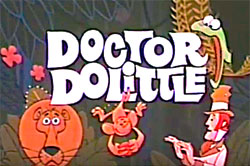 Doctor Dolittle is a very resilient property. It began in the trenches of WWI, where author Hugh Lofting, to relieve stress and boredom, wrote the stories for his kids back home. As books, they became world renowned, so much so that even Walt Disney himself attempted to gain the rights to the books (his record company would later release two versions of the movie score, one of which was displayed on the wall of the film’s producer, Arthur P. Jacobs).
Doctor Dolittle is a very resilient property. It began in the trenches of WWI, where author Hugh Lofting, to relieve stress and boredom, wrote the stories for his kids back home. As books, they became world renowned, so much so that even Walt Disney himself attempted to gain the rights to the books (his record company would later release two versions of the movie score, one of which was displayed on the wall of the film’s producer, Arthur P. Jacobs).
20th Century Fox eventually took those film rights and transformed the books into what was hoped to be Mary Poppins, The Sound of Music and My Fair Lady all rolled into one. The resulting film has been written about extensively for its budget-busting problems of location, animal wrangling and Rex Harrison antics. It’s an understatement to say that the film’s bonanza status at the box office, retail stores, music charts and Oscar shelves was over-anticipated.
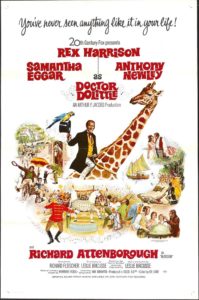 Though the 1967 film did pick up two Academy Awards (for Special Effects and Song for “Talk to the Animals”), Doctor Dolittle laid a lot of eggs. The strange thing is that, those eggs ended up everywhere and took on lives of their own. Maybe the toys and such were not big sellers, but baby boomers saw them everywhere. Maybe the soundtrack album adorned thousands of bargain bins, but that also meant a lot of us bought it. And a lot of artists recorded the songs. To a kid in the late ‘60s, “Talk to the Animals” was a standard, performed on variety shows and played on AM radio stations upon which you could still hear Sammy Davis, Jr. alongside The Beatles, Ray Conniff and Smokey Robinson. The score was outstanding no matter how some critics turned their noses up at them, with several songs gain international prominence. A London stage version proved that there was life in the ol’ Doc yet. It was the circumstances, not the elements within the property, and clearly that is not lost on those who are still captivated by it. Fox gave the 1967 movie such reach that it continued to make an impact for years.
Though the 1967 film did pick up two Academy Awards (for Special Effects and Song for “Talk to the Animals”), Doctor Dolittle laid a lot of eggs. The strange thing is that, those eggs ended up everywhere and took on lives of their own. Maybe the toys and such were not big sellers, but baby boomers saw them everywhere. Maybe the soundtrack album adorned thousands of bargain bins, but that also meant a lot of us bought it. And a lot of artists recorded the songs. To a kid in the late ‘60s, “Talk to the Animals” was a standard, performed on variety shows and played on AM radio stations upon which you could still hear Sammy Davis, Jr. alongside The Beatles, Ray Conniff and Smokey Robinson. The score was outstanding no matter how some critics turned their noses up at them, with several songs gain international prominence. A London stage version proved that there was life in the ol’ Doc yet. It was the circumstances, not the elements within the property, and clearly that is not lost on those who are still captivated by it. Fox gave the 1967 movie such reach that it continued to make an impact for years.
Indeed, while the Eddie Murphy remakes may owe little to the 1967 film, since the premise itself made it work more successfully as a contemporary comedy, there has been a bidding war for rights to a new version. Universal will release a new Dolittle starring Robert Downey, Jr. in 2019. Though no details have been disclosed about the approach of the film (except for the assumption that Downey’s Dolittle will be a tart-tongued smarty pants), the point is that the 1967 movie is imbedded in a collective psyche through years of exposure on TV and home video. In fact, an expanded soundtrack CD and Blu-ray of the 1967 version have just been released.
The reason for all this context is to explain why DePatie-Freleng and NBC would present an animated version of Doctor Dolittle two years after the movie had basically tanked. Isn’t that like producing a John Carter series two years late? Not at all. The Dolittle books, first of all, were still established on their own). And second, the movie was ubiquitous despite its box office demise. The aura surrounding movies didn’t dissipate as quickly as it seems to today.
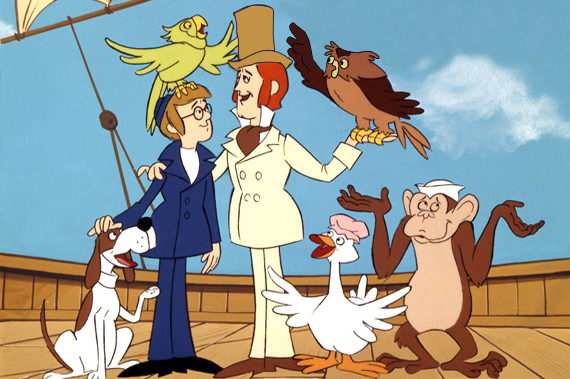
That had to be the reason DePatie-Freleng used the Oscar-winning “Talk to the Animals” as the theme song, albeit a highly grooved-up version. The lyrics were altered to set up the premise of the series, having Dolittle pursued by a comical band of pirates, led by Scurvy, who had an odd gangster look for a pirate. The cartoon also picked up the distinctive marketing font that appeared on all the film merchandise (though not on the film main titles themselves).
Purists of the Dolittle books might not have been thrilled with turning the adventures into a sitcom-like globetrotting chase, but for its purpose, it opened up the world a little bit for young viewers and invited the odd bits of education to filter their way in. Dolittle’s objective as a character is to travel the world to help animals and their environment, while Scurvy is out to learn how to talk to animals in order to, it seems, gain power and wealth—at least that’s how it’s explained. The premise more resembles the plot of Around the World in 80 Days, with Phileas Fogg chased by Inspector Fix (which became its own NBC animated series produced by Australia’s API, before Hanna-Barbera bought the studio, in 1972).
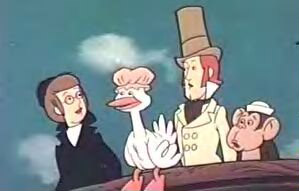 Lennie Weinrib, who became a vocal fixture of Saturday morning TV (so much so that it can have one reminiscing about those days just to hear his voice), was just getting into animation with this series, his second for DePatie-Freleng (the first being Roland and Ratfink). With his writing partner Paul Harrison–the duo also responsible for the writing on H.R. Pufnstuf–the series has the feeling of high adventure, but like Pufnstuf, it has no problem lapsing into Bob Hope-style one liners and pop culture references.
Lennie Weinrib, who became a vocal fixture of Saturday morning TV (so much so that it can have one reminiscing about those days just to hear his voice), was just getting into animation with this series, his second for DePatie-Freleng (the first being Roland and Ratfink). With his writing partner Paul Harrison–the duo also responsible for the writing on H.R. Pufnstuf–the series has the feeling of high adventure, but like Pufnstuf, it has no problem lapsing into Bob Hope-style one liners and pop culture references.
Dolittle seemed a change of pace for DePatie-Freleng, a chance to branch out into fantasy and adventure with music. At first, one might think Dolittle might have been the kind of thing their rival studios might have taken on, but maybe they wanted to widen their portfolio beyond six-minute gag cartoons. While there are some awkward aspects to their Dolittle by today’s standards, they were striving for something different yet without abandoning their house style. One of the nicest things about the show is that perennial incidental voice actor Hal Smith was given the lead role as Doctor Dolittle himself.
Weinrib and Harrison must have been closely involved with not only the premise, but also mapping out the outline of all 17 episodes so that they meshed with the songs. Unlike songs on The Archie Show or Josie and the Pussycats, most of the Grasshoppers’ songs are related to the storyline. This is a little harder to accomplish as it requires pre-planning as opposed to the luxury of tossing any song into any given chase. It may be for that reason that the writers were given credit on the album. Even though they didn’t write the songs, their scripts influenced them.
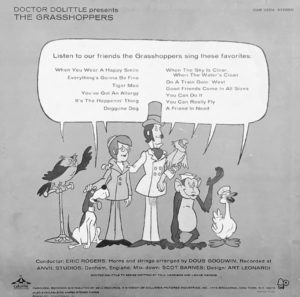 Whenever the Grasshoppers decided to perform, Dolittle opened his medical bag and it becomes a colorful band stage. What the band “played” has little stylistic connection to the rest of the show, but no less an auditory shift than the very different musical arrangements and studio vocalists that were suddenly heard when The Partridge Family performed on their show a couple of years later.
Whenever the Grasshoppers decided to perform, Dolittle opened his medical bag and it becomes a colorful band stage. What the band “played” has little stylistic connection to the rest of the show, but no less an auditory shift than the very different musical arrangements and studio vocalists that were suddenly heard when The Partridge Family performed on their show a couple of years later.
All of the music was recorded in England with British singers, a common practice for the late ‘60s. The great Mike Sammes Singers not only recorded for many Disney albums, they also can be heard on several Rankin/Bass specials and series of this period (including Tomfoolery, which ran on NBC the same year as Doctor Dolittle). It’s possible that DePatie-Freleng musical director Doug Goodwin handled much of the studio’s orchestral music for other shows overseas as well.
Unlike The Archies, the Pussycats, the Brady Kids or even the few Scooby-Doo pop songs, the Grasshoppers songs are completely child-focused and have no pretentions to do anything else but serve their source material. They do stand on their own as peppy late’60’s groovy flower power tunes, though.
Quite a few reading this Spin today might be discovering of the existence of a Doctor Dolittle cartoon series for the first time. NBC placed it at 10 a.m., against a CBS juggernaut of the brand-new Josie and the Pussycats (preceded by Sabrina and the Groovie Goolies and followed by The Harlem Globetrotters, so that couldn’t have helped its ratings.
For those who follow novelty music such as this, there might be some confusion because there are actually two children’s pop groups called “The Grasshoppers.” The first “group” was an umbrella term for Peter Pan Records various Chipmunk covers. There were quite a few of them on such labels as Spin-O-Rama, Parade, Diplomat and Tinkerbell. Hop over here for their Spin (it’s under the post about the Golden Jetsons).
The album design was created by Art Leonardi, who also staged the musical sequences and the lightning-paced titles. In a parallel universe where Doctor Dolittle the movie and the TV cartoon were phenomenal hits, it’s interesting to wonder what a “DePatie-Freleng Records” company would have been like. This is such a delightfully cartoony cover, it is fun to imagine more like it, based on other DFE cartoons.
“When the Sky is Clear, When the Water’s Clean”
Doctor Dolittle was no exception to the network efforts to add education and pro-social messages to its entertainment, so the good doctor would occasionally mention items of an informative or environmental nature. This earnest ballad is akin to The Archies’ anti-pollution anthem, “Mr. Factory,” which would appear on Archie’s Funhouse over on CBS the same year.


 GREG EHRBAR is a freelance writer/producer for television, advertising, books, theme parks and stage. Greg has worked on content for such studios as Disney, Warner and Universal, with some of Hollywood’s biggest stars. His numerous books include Mouse Tracks: The Story of Walt Disney Records (with Tim Hollis). Visit
GREG EHRBAR is a freelance writer/producer for television, advertising, books, theme parks and stage. Greg has worked on content for such studios as Disney, Warner and Universal, with some of Hollywood’s biggest stars. His numerous books include Mouse Tracks: The Story of Walt Disney Records (with Tim Hollis). Visit 





















































I stupidly passed up on one of these at a thrift store about 10 years ago. It was a dollar.
I have to check out the feature movie again. The only time I saw it was the edited for network TV version back when I was in junior high, which was during the Watergate era. Oddly this movie kind of fell down my memory hole despite being in the group with Mary Poppins, Chitty Chitty Bang Bang, and Willy Wonka. Right now I’m kind of getting into rediscovering related big budget comedies like the The Great Race and Those Magnificent Men in Their Flying Machines, which apparently cycle back and influenced cartoons like that Wacky Races and Dastardly & Muttley and Their Flying Machines.
DePatie-Freling also had another Fantasy series at the time with Here Comes the Grump. Supposedly that was influenced by the Yellow Submarine but it wasn’t quite as surrealistically whimsical and was lacking in a luscious Pop Rock and Pop orchestral soundtrack. I did like the magical flying machine, similar to the one in the Rankin-Bass Here Comes Peter Cottontail. Both were Steampunk decades before Steampunk!
One episode had a fox inspired by Don Adams’ Maxwell Smart character.
I was familiar with Dr. Dolittle through the Random House Beginner Books (same publishers of Seuss’ work).I saw the movie Dr. Dolittle locally as a child but certainly not in 1967 first run. I am guessing spring or summer 1969, and it wasn’t a one-off matinee, it was running for a duration. Whether it was a re-release or it was still making rounds, this certainly shows the legs the franchise had.
P.S.- I remember enjoying it. Movies were a rarer treat. Color was as rare. We were a drive-in type family and this was in a newer concept mall cinema. It all held-up to my eight year old taste buds.
I do remember the cartoon but I think because it did not look like the movie or the Hugh Lofting illustrations, I did not warm up to it. Maybe one more reimagining was too much for me in such a short time after I discovered the character. But of everything form the cartoon, The Grasshoppers I remember the most.
I do remember watching both the Doctor Dolittle and Tomfoolery cartoons on their original runs, and I did notice the similarity of style in both series’ songs. (Though I was around 9 then, I wondered just how Scurvy could profit from learning Dolittle’s “secret” of conversing with animals. I thought it was just a natural ability the doctor had.)
To a child at the time of the feature film’s release, there was NO evidence that it did poorly at the box office. Many of my friends saw it and loved it. (Our family missed it. My parents couldn’t afford to take us to movies very often.) The stores had Doctor Dolittle beach towels, wrist watches, plush toys, you name it. The Hugh Lofting books were available singly or in a fancy box set. The songs, especially “Talk to the Animals” and “Something in Your Smile” were played on the radio for weeks. This has got to have been one of the most hyped movies in film history.
So needless to say, the animated TV series seemed like a somewhat logical extension of the movie. I was disappointed that the characters didn’t follow Hugh Lofting’s design–either in the feature film or the cartoon series. A tall thin Dr. Dolittle just seems wrong to me. I, too, wondered about the villain’s motives…if he could think up all of those diabolical plots, why did he need to trouble to get the secrets of the good doctor, especially where he always got the worst of it?
Frederick Wiegand makes some excellent points (as usual) here. It’s still true that few movies have ever been so hyped or promoted as the 1967 release of DOCTOR DOLITTLE. It was probably the most extensively marketed roadshow movie ever. For months, a gigantic block-long billboard in Times Square promoted the film’s reserved seat engagement at the Rivoli. THE SOUND OF MUSIC — the top-grossing movie of the ’60s — had set box-office records, and Fox didn’t simply anticipate that DOLITTLE would surpass it, the studio clearly expected it. Fox pulled out all the stops. In addition to the standard roadshow hoopla, shops were flooded with DOLITTLE merchandise, kids’ cereal boxes were adorned with bursts featuring DOLITTLE premiums, the Lofting books were reissued, and those damn Bricusse songs were covered by many, many M-O-R artists.
By the time I saw DOLITTLE — in late ’68, at “popular prices” after its tepid reserved seat run — it was considerably shortened from its roadshow version, but still way too long and painfully low. I was amazed that the much hyped “Something in Your Smile” (heard for years in Muzak-programmed elevators) has apparently been cut from the picture. Years later I picked up the Fox soundtrack lp in a cut-out bin and finally heard Harrison’s rendition.
In the late ’60s, John Gregory Dunne wrote “The Studio,” a quite interesting book about 20th Century Fox in 1967; since Fox’s big movie for the year was DOLITTLE, there are fascinating details about the film’s production and post-production. [Mark Harris’ later “Pictures from a Revolution,” has even more detail about the making of the movie, including troubling stories of an out-of-control Rex Harrison and the long efforts to cast either Sidney Poitier or Sammy Davis, Jr.. in a role later cut from the script (Davis would, of course, eventually record an entire album of DOLITTLE songs).]
The backstory highlight for me remains Dunne’s account of the first preview of the movie, in which the very long film was not terribly well received. The studio brass that bight decided to immediately make a number of cuts, including a lengthy African-set prologue featuring Doctor Dolittle aiding and ministering to nay number of animals large and small. The studio did not immediately realize, however, that the scene in which the good Doctor rides a giraffe — the centerpiece image of the film’s planned advertising and promotion campaign (as seen in the poster image above) — occurred in the now deleted prologue. Some tricky editing followed, and the shot of Dolittle and giraffe was awkwardly inserted late in the film (the Doctor’s clothing suddenly changes) and the problem was (sort o)f solved.
The movie is a disaster in many ways, (I loved the Lofting books, and the Bricusse script was a travesty, not to mention, that awful score) but I must confess a longtime wish — I’d love to have seen that long preview cut with the prologue.. Hey, In for a penny…
Honestly, I don’t know why a great deal of people dislike this movie. It’s not so bad as most people think it is. My dad actually saw it when it was originally released to theaters at the age of 5. He also Chitty Chitty Bang Bang in theaters during its original release 50 years ago.
To this day, I have seen only one animated film that used Hugh Lofting’s original designs for Doctor Dolittle, Polynesia, Gub-Gub and other animal friends. That was Lotte Reiniger’s 1928 silhouette film series: “Dr. Dolittle and His Animals”, consisting of three parts, “A Journey To Africa”, “The Monkey Bridge” and “The Monkey Illness”. These films were dubbed and released to television in the early 1950s, and remain the most faithful film adaptations of Lofting’s books. Look for them on YouTube.
Wow! Had no idea! Never heard of it! Thank you!
Back in pre-video days, a Big Deal “Roadshow” Movie might play first-run theaters for well over a year, then have a equally long life in neighborhood houses (“at popular prices!”). “Sound of Music” held one of the domed Century theaters for that long. Possible that the animated show was in the talking stages when the movie first appeared, with everybody presuming the movie would still be playing in theaters two years out (even if half of a double feature).
My two cents on “Doctor Dolittle”: Seen today, it’s a SLOW film, taking forever to get to its stated plot (a voyage). Maybe it was a slower era; the insanely successful “Around the World in Eighty Days” is downright leisurely. “Chitty Chitty Bang Bang” actually improved with age, now that one could appreciate the comic grotesque streak and the peculiar James Bond vibe (same producers, same mock epic feel).
All right, we’ll agree to disagree on the merits of the Leslie Bricusse score for the risible DOLITTLE feature film (a gigantic flop given its enormous costs and sky-high expectations)… but this was an excellent post, with swell background on a nearly forgotten DFE series. Fascinating details. I never would have guessed that a record of “The Grasshoppers” songs from the show existed. I wonder — was there a TOMFOOLERY lp?
I WISH there was a Tomfoolery LP! Though Rankin/Bass often made promotion records from their specials, I don’t know if that extended to their series. But this one series was perhaps their most unique, bizarre and should never have been on Saturday morning because it was too surreal — sorry for the cliche, but it was ahead of its time. As a record it would have been fantastic, since the songs were sung by the Mike Sammes Singers, who did most of the vocal work on the cartoons during this time.
Nostalgia for a lot of us is cartoon characters with their eye whites not painted in. I can’t think how I missed this one. Check out all the animation A-listers who worked on it!
There is one episode where they get this Bird to fly even though he is afraid at first to fly however he dose fly and saves Dolitle and the rest of them thanks to The Grasshoppers